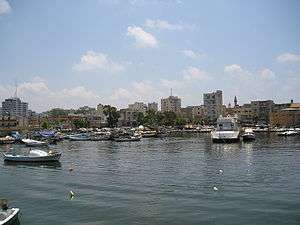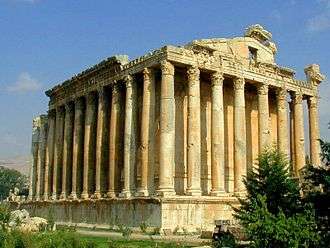Tyre, Lebanon
| Tyre | |
|---|---|
| City | |
|
Tyre fishing harbor | |
 Tyre | |
| Coordinates: 33°16′15″N 35°11′46″E / 33.27083°N 35.19611°ECoordinates: 33°16′15″N 35°11′46″E / 33.27083°N 35.19611°E | |
| Country |
|
| Governorate | South |
| District | Tyre |
| Established | 2750 BC |
| Area | |
| • City | 4 km2 (2 sq mi) |
| • Metro | 17 km2 (7 sq mi) |
| Population | |
| • City | 60,000 |
| • Metro | 174,000 |
| Time zone | EET (UTC+2) |
| • Summer (DST) | EEST (UTC+3) |
| Type | Cultural |
| Criteria | iii, vi |
| Designated | 1984 (8th session) |
| Reference no. | 299 |
| State Party |
|
| Region | Arab States |
Tyre (Arabic: صور, Ṣūr; Phoenician: 𐤑𐤅𐤓, Ṣur; Hebrew: צוֹר, Tsor; Tiberian Hebrew צֹר, Ṣōr; Akkadian: 𒀫𒊒, Ṣurru; Greek: Τύρος, Týros; Turkish: Sur; Latin: Tyrus, Armenian Տիր [Dir]), sometimes romanized as Sour, is a city in the South Governorate of Lebanon. There were approximately 117,000 inhabitants in 2003.[1] However, the government of Lebanon has released only rough estimates of population numbers since 1932, so an accurate statistical accounting is not possible.[2] Tyre juts out from the coast of the Mediterranean and is located about 80 km (50 mi) south of Beirut. The name of the city means "rock"[3] after the rocky formation on which the town was originally built. The adjective for Tyre is Tyrian, and the inhabitants are Tyrians.
Tyre is an ancient Phoenician city and the legendary birthplace of Europa and Dido (Elissa). Today it is the fourth largest city in Lebanon after Beirut, Tripoli and Sidon.[4] and houses one of the nation's major ports. Tourism is a major industry. The city has a number of ancient sites, including its Roman Hippodrome which was added to UNESCO's list of World Heritage Sites in 1979.[5][6]
History

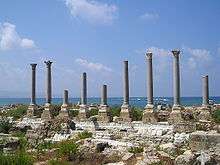
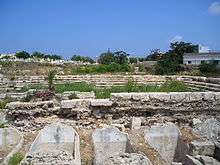
Tyre originally consisted of two distinct urban centres, Tyre itself, which was on an island just off shore, and the associated settlement of Ushu on the adjacent mainland. Alexander the Great connected the island to the mainland by constructing a causeway during his siege of the city,[7] demolishing the old city to reuse its cut stone.[8]
The original island city had two harbours, one on the south side and the other on the north side of the island. It was the two harbours that enabled Tyre to gain the maritime prominence that it did; the harbour on the north side of the island was, in fact, one of the best harbours on the eastern end of the Mediterranean. The harbour on the south side has silted over, but the harbour on the north side (see Tyre harbor photo the right) is still in use.[9]
In ancient times, the island-city of Tyre was heavily fortified and the mainland settlement, originally called Ushu (later called Palaetyrus, meaning "Old Tyre," by the ancient Greeks) was actually more like a line of suburbs than any one city and was used primarily as a source of water and timber for the main island city.[10] Josephus records that the two fought against each other on occasion,[11] but most of the time, they supported one another because they both benefited from the island city's wealth from maritime trade and the mainland area's source of timber, water and burial grounds.
Foundation
Tyre was founded around 2750 BC according to Herodotus and was originally built as a walled city upon the mainland.[12] Tyre's name appears on monuments as early as 1300 BC. Philo of Byblos (in Eusebius) quotes the antiquarian authority Sanchuniathon as stating that it was first occupied by Hypsuranius. Sanchuniathon's work is said to be dedicated to "Abibalus king of Berytus"—possibly the Abibaal who was king of Tyre.[13]
There are ten Amarna letters dated 1350 BC from the mayor, Abimilku, written to Akenaten. The subject is often water, wood and the Habiru overtaking the countryside of the mainland and how that affected the island-city.
Early history
The commerce of the ancient world was gathered into the warehouses of Tyre.
Tyrian merchants were the first who ventured to navigate the Mediterranean waters; and they founded their colonies on the coasts and neighbouring islands of the Aegean Sea, in Greece, on the northern coast of Africa, at Carthage and other places, in Sicily and Corsica, in Spain at Tartessus and even beyond the pillars of Hercules at Gadeira (Cádiz).[14]
The city of Tyre was particularly known for the production of a rare and extraordinarily expensive sort of purple dye, produced from the murex shellfish, known as Tyrian purple. The colour was, in ancient cultures, reserved for the use of royalty or at least the nobility.[15]
Phoenicians from Tyre settled in houses around Memphis, south of the temple of Hephaestus in a district called the Tyrian Camp.[16]
Tyre was often attacked by Egypt and was besieged by Assyrian king Shalmaneser V, who was assisted by the Phoenicians of the mainland, for five years. From 586 until 573 BC, the city was besieged by Nebuchadnezzar II of Babylon until it agreed to pay a tribute.[17]
The Achaemenid Empire conquered the city in 539 BC and kept it under its rule until Alexander the Great laid siege to the city, conquered and razed it in 332 BC.[18] In 315 BC, Alexander's former general Antigonus began his own siege of Tyre,[19] taking the city a year later.[20]
In 126 BC, Tyre regained its independence from the Seleucid Empire[21] and was allowed to keep much of its independence, as a "civitas foederata",[22] when the area became a Roman province in 64 BC.[23] Tyre continued to maintain much of its commercial importance until the Common Era.
Later history
It is stated in the Bible that Jesus visited the region of Tyre and Sidon and healed a Gentile (Matthew 15:21; Mark 7:24) and from this region many came forth to hear him preaching (Mark 3:8; Gospel of Luke 6:17, Matthew 11:21–23). A congregation was founded here soon after the death of St. Stephen. Paul the Apostle, on his return from his third missionary journey, spent a week in conversation with the disciples there. According to Irenaeus of Lyon in On the Detection and Overthrow of the So-Called Gnosis, the female companion of Simon Magus came from here.
The famous "Arch of Hadrian" and one of the best hippodromes in the region were constructed during the Roman empire.[24]
In the Revolt of Tyre (996–998), the populace of the city rose against Fatimid rule, led by an ordinary sailor named 'Allaqa - but were brutally suppressed in May 998.
After the first failed siege in 1111, Tyre was captured during the First Crusade in 1124 and became one of the most important cities of the Kingdom of Jerusalem. It was part of the royal domain, but there were also autonomous trading colonies there for the Italian merchant cities. The city was the site of the See of Tyre whose archbishop was a suffragan of the Latin Patriarch of Jerusalem; its archbishops often acceded to the Patriarchate. The most notable of the Latin archbishops was the historian William of Tyre.
After the reconquest of Acre by Richard I of England on July 12, 1191, the seat of the kingdom moved there, but coronations were held in Tyre. In the 13th century, Tyre was separated from the royal domain as the Lordship of Tyre. In 1291, it was retaken by the Mamluk Sultanate, which then was followed by Ottoman rule before the modern state of Lebanon was declared in 1920.
After 1920

The present city of Tyre covers a large part of the original island and has expanded onto and covers most of the causeway, which had increased greatly in width over the centuries because of extensive silt depositions on either side. The part of the original island not covered by the modern city of Tyre is mostly of an archaeological site showcasing remains of the city from ancient times.
After numerous attacks and reprisals involving the PLO, including an assassination attempt on Israeli ambassador Argov, Israel invaded, [called the 1978 South Lebanon conflict], and Tyre was badly damaged. It was damaged again in the 1982 Lebanon War between Israel and the Palestine Liberation Organization (PLO). The city was used as a base by the PLO and was nearly destroyed by Israeli artillery.[25] After the 1982 war, the city was the site of an Israeli military post. In late 1982, and again in November 1983, buildings housing Israeli headquarters were destroyed by bombs, causing dozens of deaths in both cases and known in Israel as the First and Second Tyre Catastrophes. The 1983 explosion by a suicide truck happened only 10 days after similar attacks, the 1983 Beirut barracks bombings of US Marines and French paratroop barracks. Israel and the US blame Iran and Hezbollah for all explosions, but they have denied any involvement.
During Israel's invasion in the 2006 Lebanon War, several rocket-launching sites used by Hezbollah to attack Israel were located in rural areas around the city.[26] At least one village near the city was bombed by Israel as well as several sites within the city, causing civilian deaths and adding to the food shortage problem inside Tyre.[27] Shayetet 13 (Israeli naval commandos) also raided Hezbollah targets within the city.[28]
Geography
The Tyre Coast Nature Reserve covers over 380 hectares (940 acres) and divided into three zones: the Tourism zone (public beaches, the old city and Souks, the ancient port), the Agricultural and Archaeological zone, and the Conservation zone that includes the Phoenician springs of Ras El Ain. Due to its diverse flora and fauna, the reserve is a designated Ramsar Site. It is an important nesting site for migratory birds and the endangered Loggerhead and green sea turtle and the shelter of the Arabian spiny mouse and many other important creatures (including wall lizards, common pipistrelle, and european badger).[29][30]
Cultural heritage
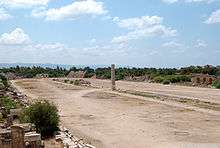
Threats to Tyre's ancient cultural heritage include development pressures and the illegal antiquities trade.[31] A highway, planned for 2011, is expected to be built in areas that are deemed archaeologically sensitive. A small-scale geophysical survey indicated the presence of archaeological remains at proposed construction sites. The sites have not been investigated. Despite the relocation of a proposed traffic interchange, the lack of precise site boundaries confuses the issue of site preservation.[32]
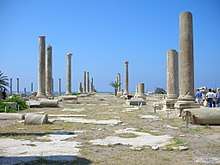
The hostilities of the 2006 Lebanon War put the ancient structures of Tyre at risk. This prompted UNESCO's Director-General to launch a "Heritage Alert" for the site.[33] Following the cessation of hostilities in September 2006, a visit by conservation experts to Lebanon observed no direct damage to the ancient city of Tyre. However, bombardment had damaged frescoes in a Roman funerary cave at the Tyre Necropolis. Additional site degradation was also noted, including "the lack of maintenance, the decay of exposed structures due to lack of rainwater regulation and the decay of porous and soft stones".[32] Like many of the cities in the Levant and in Lebanon, the architecture since the Lebanese Civil War in the 1970s has been of poor quality, which tend to threaten the cultural heritage in the built environment before the war.
Scriptural
The Hebrew Bible makes several references to Tyre:
- King Hiram I was a contemporary of David and Solomon in 2 Samuel 5:11, 1 Kings 5:1, and 1 Chronicles 14:1.
- Tyre is mentioned in the Book of Isaiah (Isaiah 23), the Book of Jeremiah (Jer 25:22, Jer 47:4), the Book of Ezekiel (Ezekiel 26-28), the Book of Joel (Joel 3:4-8), the Book of Amos (Amos 1:9-10), the Psalms, and the Book of Zechariah (Zechariah 9:3-4), which prophesied its destruction.
- Jesus visited the region or "coasts" (King James Version) of Tyre and Sidon (Matthew 15:21; Mark 7:24) and from this region many came forth to hear him preaching (Mark 3:8; Luke 6:17), leading to the stark contrast in Matthew 11:21–23 to his reception in Korazin and Bethsaida.
- In the Book of Revelation, Revelation 18 alludes extensively to the mercantile description of Tyre in Ezekiel 26-28.
Other writings
- In 19th-century Britain, Tyre was several times taken as an exemplar of the mortality of great power and status, for example by John Ruskin in the opening lines of The Stones of Venice and by Rudyard Kipling's Recessional.
Education
Collège Élite, a French international school, is in Tyre. Jaafareya High School was the first intermediate and secondary school in south of Lebanon.
Demographics
The population of Tyre is a predominantly Shia Muslim with a small but noticeable Christian community. However, the city of Tyre is home for more than 60,000 Palestinian refugees who are mainly Sunni Muslim. The Amal Movement and Hezbollah are the most popular parties, representing all of the Shi'a seats in the city as of the 2009 elections. In 2010, it was estimated Christians accounted 10% of Tyre's population.[34]
Gallery
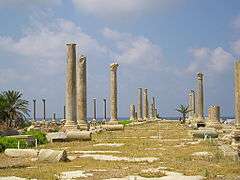 Main colonnaded street at Al Mina excavation site
Main colonnaded street at Al Mina excavation site Al Mina excavation area – supposed Roman agora
Al Mina excavation area – supposed Roman agora A typical narrow street in the Christian quarter
A typical narrow street in the Christian quarter Tyre harbor
Tyre harbor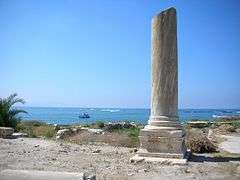 A half-column giving view to the sea
A half-column giving view to the sea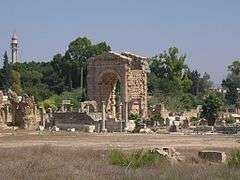 Remains seen at the excavation site
Remains seen at the excavation site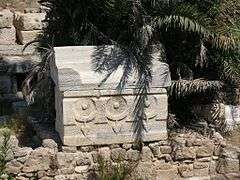 Sarcophagus in Tyre
Sarcophagus in Tyre
Twin towns – sister cities
Tyre is twinned with:
Notable people
- Antipater of Tyre (1st Century BC), Stoic philosopher
- Apollonius of Tyre (philosopher) (c. 50 BC), philosopher
- Ulpianus (late 2nd Century BC), Roman jurist
- Diodorus of Tyre (late 2nd Century BC), Peripatetic philosopher
- Saint Christina of Tyre (3rd century) Martyr[36]
- Porphyry, Neoplatonic philosopher and writer
See also
Dido
References
- ↑ Lebanon – city population
- ↑ Lebanon Population
- ↑ (Bikai, P., "The Land of Tyre", in Joukowsky, M., The Heritage of Tyre, 1992, chapter 2, p. 13)
- ↑ Tyre City, Lebanon
- ↑ Resolution 459
- ↑ Lebanon's Archaeological Heritage Archived March 11, 2009, at the Wayback Machine.
- ↑ Presutta, David. The Biblical Cosmos Versus Modern Cosmology. 2007, page 225, referencing: Katzenstein, H.J., The History of Tyre, 1973, p.9
- ↑ Robin Lane fox, Alexander the Great 1973:181f.
- ↑ See Jidejian, Nina. Tyre Through the Ages, 1969, for further information about the history of Tyre and its present condition.
- ↑ 'Tyre' from Encyclopædia Britannica 11th ed.
- ↑ Historical references to Tyre
- ↑ Bement, R B. Tyre; the history of Phoenicia, Palestine and Syria, and the final captivity of Israel and Judah by the Assyrians. Ulan Press. p. 47. ASIN B009WP2MR8.
- ↑ Vance, Donald R. (March 1994) "Literary Sources for the History of Palestine and Syria: The Phœnician Inscriptions" The Biblical Archaeologist 57(1), pp. 2–19
- ↑ from 'Tyre' in Easton's Bible Dictionary
- ↑ Bariaa Mourad. "Du Patrimoine à la Muséologie : Conception d'un musée sur le site archéologique de Tyr",(Thesis); Museum National d'Histoire Naturelle (MNHN), Study realised in cooperation with the Unesco, Secteur de la Culture, Division du Patrimoine Culturel, Paris, 1998
- ↑ Herodotus. The Histories. Oxford World's Classics. p. 137. ISBN 9780199535668.
- ↑ Bement, R B. Tyre; the history of Phoenicia, Palestine and Syria, and the final captivity of Israel and Judah by the Assyrians. Ulan Press. p. 48. ASIN B009WP2MR8.
- ↑ "Tyre in the early Persian period (539-486 B.C)". Retrieved 9 November 2014.
- ↑ 315 B.C. – events and references
- ↑ 314 B.C. – events and references
- ↑ 126 B.C. – events and references
- ↑ E. G. Hardy, Roman Laws and Charters, New Jersey 2005, p.95
- ↑ 64 B.C. – events and references
- ↑ Video showing the Roman hippodrome of Tyre
- ↑ The toll of three cities, The Economist June 19, 1982. p. 26.
- ↑ Butcher, Tim. Rebels were ready for attacks. Sydney Morning Herald 27 July 2006.
- ↑ Engel, Richard. Desperation descends on Tyre, Lebanon. MSNBC 25 July 2006.
- ↑ Israeli commandos stage Tyre raid BBC 5 August 2006.
- ↑ "Protecting marine biodiversity in Lebanon". International Union for Conservation of Nature (IUCN). 2 May 2012.
- ↑ Hany El Shaer; Ms. Lara Samaha; Ghassan Jaradi (Dec 2012). "Lebanon’s Marine Protected Area Strategy" (PDF). Lebanese Ministry of Environment.
- ↑ Helga Seeden (December 2, 2000). "Lebanon's Archaeological Heritage".
- 1 2 Toubekis, Georgios (2010). "Lebanon: Tyre (Sour)". In Christoph Machat, Michael Petzet and John Ziesemer (Eds.), "Heritage at Risk: ICOMOS World Report 2008-2010 on Monuments and Sites in Danger" (PDF).. Berlin: hendrik Bäßler verlag, 2010, pg. 118.
- ↑ Koïchiro Matsuura; The Director-General of UNESCO (August 11, 2006). "UNESCO Director-General Launches "Heritage Alert" for the Middle East". UNESCO World Heritage Centre.
- ↑ http://www.asianews.it/news-en/Bishop-of-Tyre:-Christians-in-Lebanon-have-become-a-minority-in-their-country-17638.html
- ↑ El Corresponsal de Medio Oriente y Africa - Málaga recupera su pasado fenicio
- ↑ "Saint Christina of Tyre (July 24)". Official website of the Antiochian Orthodox Christian Archdiocese of Australia, New Zealand and the Philippines. Retrieved September 27, 2015.
External links
| Wikimedia Commons has media related to Tyre. |
| Wikivoyage has a travel guide for Tyre. |
- 360 Panorama of Tyre's Archeological Site
- Lebanon, the Cedars' Land: Tyre
- photo 2u
- Tyre entry in historical sourcebook by Mahlon H. Smith with picture of Tyrian silver shekel.
- Alexander's Siege of Tyre at Ancient History Encyclopedia by Grant Nell
- American University of Beirut (AUB) Museum team discovers first Phoenician Temple in Tyre; only complete one in Lebanon
![]() This article incorporates text from a publication now in the public domain: Easton, Matthew George (1897). "article name needed". Easton's Bible Dictionary (New and revised ed.). T. Nelson and Sons.
This article incorporates text from a publication now in the public domain: Easton, Matthew George (1897). "article name needed". Easton's Bible Dictionary (New and revised ed.). T. Nelson and Sons.
